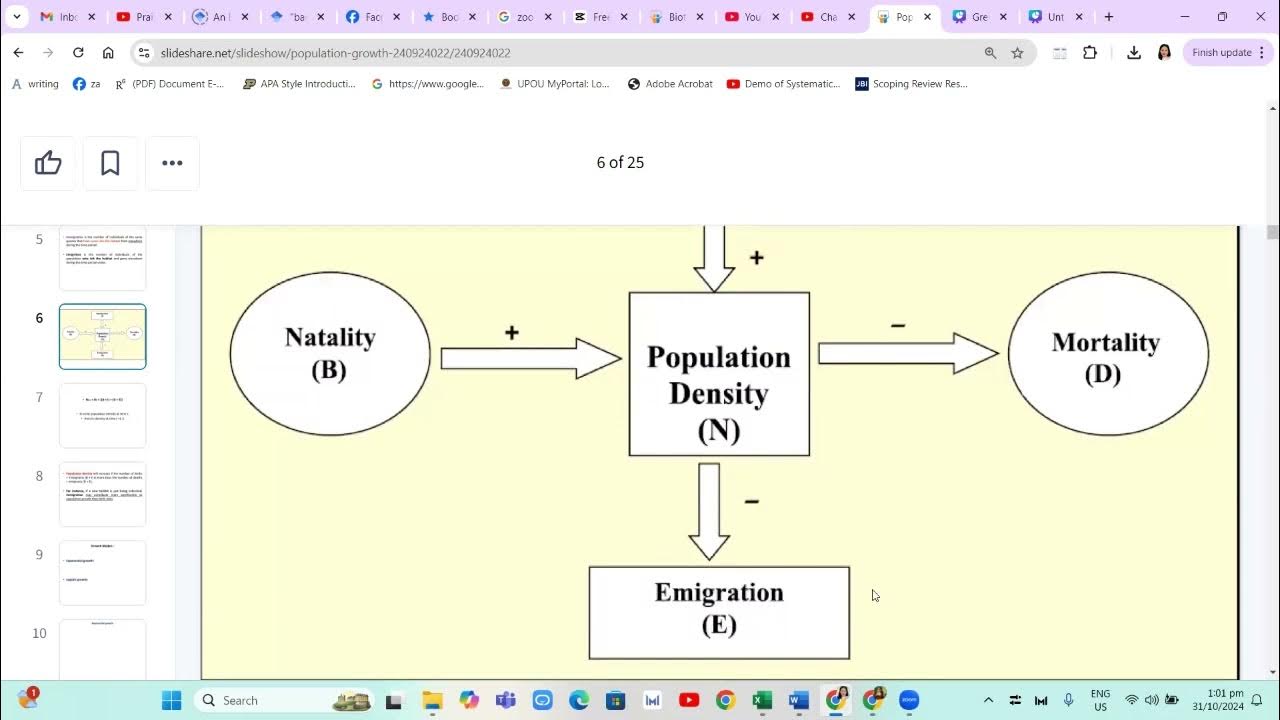Changing the Population Growth Rate: Solow Growth Model
Summary
TLDRThis video explores how changes in population growth rates affect the solar growth model, particularly through the break-even investment curve. As population growth increases, the curve steepens, leading to a lower steady-state capital and output per worker, as predicted by the Solow model. The dynamics illustrate that higher population growth necessitates more investment to maintain capital per capita, resulting in decreased economic output per worker in the long run. Conversely, reducing population growth can enhance steady-state outcomes. The video highlights the crucial relationship between population growth and aggregate economic performance.
Takeaways
- 📈 The solar growth model incorporates population growth rates, impacting overall investment dynamics.
- 🔄 An increase in population growth from n1 to n2 results in a steeper break-even investment curve.
- 📉 Higher population growth leads to a lower steady-state capital per capita (k*), as shown in the model.
- 🔍 The break-even investment curve is influenced by both depreciation and the population growth rate.
- 💡 In the long run, increased population growth results in lower income per worker according to the Solow model.
- 🔗 The dynamics of the model indicate that actual investment may not meet break-even investment needs, leading to a decline in capital stock.
- 🌱 Aggregate economic growth can occur due to population growth, even if output per worker remains at steady state.
- 🧮 The growth rate of aggregate output (Y) is defined as the sum of the growth rates of per capita output and labor force growth.
- 🔧 In steady state, while per capita output grows at zero rate, aggregate output grows at the rate of population growth (n).
- 🎥 The next topic will cover consumption and the golden rule steady-state output in the following video.
Q & A
What is the main focus of the video script?
-The video script focuses on how changes in the population growth rate affect the Solow growth model, specifically regarding investment, steady state capital, and aggregate economic growth.
How does an increase in the population growth rate influence the break-even investment curve?
-An increase in the population growth rate causes the break-even investment curve to become steeper, which means that a higher investment is needed to maintain capital levels.
What are the implications of a steeper break-even investment curve for steady state capital?
-A steeper break-even investment curve leads to a lower steady state capital per capita, ultimately reducing both capital stock and output per worker.
What happens to the capital stock when actual investment is lower than the required break-even investment?
-When actual investment is lower than the required break-even investment, the capital stock declines, moving the economy to a new steady state with lower capital per capita.
What does the script suggest about the relationship between population growth and aggregate economic growth?
-The script suggests that while per capita output reaches a steady state with zero growth, aggregate output can still grow at the same rate as the population growth rate, allowing for overall economic growth.
What does the steady state imply about output per worker in the long run?
-In the long run, output per worker stabilizes at a steady state where growth is zero, even though the aggregate output grows with the population.
What role does depreciation play in the investment model discussed?
-Depreciation is a key factor in determining the break-even investment level, as it combines with population growth to affect the slope of the investment curve.
What happens to the model dynamics if the population growth rate decreases?
-If the population growth rate decreases, the break-even investment curve flattens, leading to an increase in the steady state capital and output per worker.
How does the script define aggregate output?
-Aggregate output is defined as per capita output multiplied by the labor force, emphasizing its dependence on both productivity and labor growth.
What future topics does the speaker plan to cover in upcoming videos?
-The speaker plans to cover topics such as consumption and the golden rule steady state output in future videos.
Outlines

Dieser Bereich ist nur für Premium-Benutzer verfügbar. Bitte führen Sie ein Upgrade durch, um auf diesen Abschnitt zuzugreifen.
Upgrade durchführenMindmap

Dieser Bereich ist nur für Premium-Benutzer verfügbar. Bitte führen Sie ein Upgrade durch, um auf diesen Abschnitt zuzugreifen.
Upgrade durchführenKeywords

Dieser Bereich ist nur für Premium-Benutzer verfügbar. Bitte führen Sie ein Upgrade durch, um auf diesen Abschnitt zuzugreifen.
Upgrade durchführenHighlights

Dieser Bereich ist nur für Premium-Benutzer verfügbar. Bitte führen Sie ein Upgrade durch, um auf diesen Abschnitt zuzugreifen.
Upgrade durchführenTranscripts

Dieser Bereich ist nur für Premium-Benutzer verfügbar. Bitte führen Sie ein Upgrade durch, um auf diesen Abschnitt zuzugreifen.
Upgrade durchführenWeitere ähnliche Videos ansehen
5.0 / 5 (0 votes)






